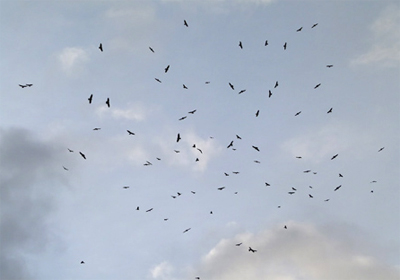|
The next morning
I followed the birds as they lifted, circled and streamed north then west
to avoid the imposing height of Toro Peak at 8700 feet. Coyote Canyon
provided an exit from Borrego Valley. The canyon cuts between the San Ysidro Mountains to the west and the Santa
Rosa Range dominated by Toro Peak to the north. This access route allows
the birds to continue their journey north.
During the first
two weeks in March I concentrated my efforts on locating a site to watch
the migration of vultures. At this point I was satisfied working with
turkey vultures. On March 9th I counted an unknown raptor from a great
distance. It looked buteo-like but was slimmer than a redtail. The bird
did not register quite right. Later I realized that this was perhaps my
first of many Swainson's hawks to move through the valley.
 Swainson's Hawk and
Moon - photo by Ray Spence |
I located the watch at the junction of Henderson Canyon and Borrego
Springs Road.
I returned to the
watch site March 2, temperature 83 degrees, 10% clouds, wind ESE 5 mph,
humidity 21% visibility unlimited. At 8:11AM 25 Swainson's kettled up and
flew directly overhead and across the ridge. At 8:14 a.m., 8 Swainson’s
followed the same route. Birds continued to stream overhead until 8:50
a.m. the totals in less than an hour were 63 Swainson's and 2 turkey
vultures. On March 11, I left the watch at 9 a..m. and headed home. As I turned
south on DiGiorgio Road I spied a kettle (a large group of hawks swirling
around presenting the shape of a kettle) of what appeared to be ravens. I
stopped my truck and swung my binocs up to reveal a kettle of 16
Swainson's hawks. They began to stream north and then west through Coyote
Canyon. |
Immediately I scanned back to the area where the first kettle
formed. Another kettle began to rise from the same area. I counted 17 Swainson's in this second group. They followed the same path out of the
valley. For the next week only 10 more Swainson's were observed. On March
18th I left for a week in Mexico, returning March 25th.
On April 5th I
decided to relocate the watch to DiGiorgio Road to intercept birds
directly in their feeding and roosting area. Many birds were on the ground
and in the tamarisks. Kettles began to form at 8 a.m. Totals in three
hours of observation were 5 tv's and 105 Swainson's. It was
apparent that hawks most be coming into the valley in the evening so I
returned to DiGiorgio Road at 5:30 p.m. and found 22 birds close to the
ground but flying. As darkness approached, I slowly drove DiGiorgio Road
home.
I noticed a huge kettle of birds to the southeast as I drove. Stopping
next to the road, I quickly focused on what was the biggest kettle of
Swainson's I had ever seen. “Tornado! by gosh a tornado of hawks!” I
shouted with no one nearby to hear. The hawks ranged from ground level to
heights of at least 1,000 feet. A car pulled up and two young watchers
emerged. They had never seen a Swainson's Hawk in their life (lives?) and
now we were witnessing hundreds. It was rapidly becoming dark as the birds
began to descend. I counted in tens then 50's as the birds streamed
north. “Gads!” I shouted, "they are splitting up." In fact, the majority
of birds continued north and a splinter group flew west, directly over us.
I followed the larger part of the group north as they began to descend
toward Coyote Canyon. By 6:30 p.m. it was too dark to follow the birds. I
estimated around 700 to1,000 were in the kettle.
| On April 6 we counted only 210 Swainson's. The remainder had made it
through. Coyote Canyon the prior evening. We were now convinced that the
birds were coming into the valley in the evening, roosting and feeding on
the caterpillars in the morning. The large group that came in April 5th
split with the majority gliding into Coyote Canyon to feed further north.
On April 7 over 100 hawks were on the ground this morning, suggesting
that again we missed a movement the prior evening. We were now determined
to witness migration into the valley.
|

First kettle of the day |
A total of 185 Swainson's departed
today. We returned in the evening and spotted 21 hawks descending into the
area. Another 30 were already on the ground or in the trees. Migration continued daily with totals for the period April 8-19 of 267.
The grand total for the season included 2031 Swainson's Hawks, 310 Turkey
Vultures, 1 Osprey, 2 Northern Harriers, 1 Redtail, 1 Ferruginous Hawk,
and 1 Golden Eagle. We spent 74 hours at the watch. Our average hourly
total was 31.7 hawks.
Swainson's Hawks are endangered in California. They migrate from the
pampas of Argentina to as far north as Alaska. The central valley of
California still has a few nesting birds. The work we have begun on
Swainson's Hawks may help determine if a viable population is increasing.
Next spring we will try to retrieve feathers to be used in genetic
studies, linking our sightings with nesting Swainson's further north.
2004 hopefully will bring the hawks back to the valley. Many questions
still remain unanswered. We now know, however, that Southern California
has a new hawkwatch.
Join Biologist Hal Cohen each Spring in Borrego Springs as the annual Swainson's
Hawk Watch gets underway.
Check our website for up dates in late January or February.
|